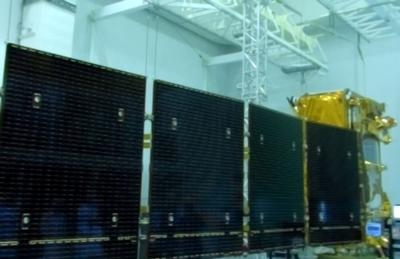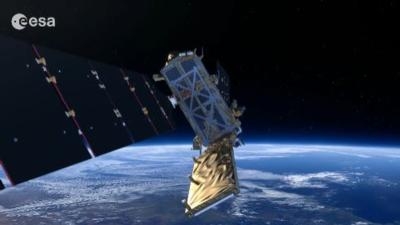Mon, Mar 03, 2014
Engineers On Earth Rehearsing Solar Panel Deployment
When Europe's environmental monitoring satellite Sentinel-1 is placed in orbit in a few weeks, it has to perform a complicated dance routine to unfold its large solar wings and radar antenna. Engineers have recently been making sure the moves are well rehearsed. Sentinel-1 is the first in a family of satellites built specifically to provide a stream of timely data for Europe’s ambitious Copernicus environmental monitoring program.

The spacecraft carries an advanced radar instrument to image Earth’s surface through cloud and rain, regardless of whether it is day or night. Delivering vital information for numerous operational services, from monitoring ice in the polar oceans to tracking land subsidence, Sentinel-1 is set to play a key role in the largest civil Earth-observation program ever conceived. Moreover, this new mission is the only European satellite specifically designed for fast response to emergencies such floods and earthquakes.
About seven years in the making, this new satellite will soon be launched from Europe’s Spaceport in French Guiana. Sentinel-1 will be shipped to the launch site next week, but has spent the last couple of months at Thales Alenia Space in Cannes, France, being put through a last set of stringent tests.
This included suspending the satellite from a structure to simulate weightlessness and carefully unfolding the solar wings and the 36-foot-long radar.
During launch, the solar wings and radar are folded up for protection and to fit into the Soyuz rocket fairing. After the satellite is released into space, the solar wings and radar deploy together, but in a specific sequence that takes around 10 hours to complete. The sequence is unique, choreographed to ensure that both deploy in the safest possible way.

The sequence also allows power from the wings to be available as soon as possible so that the satellite is independent. The tests have shown that Sentinel-1 can handle this tricky sequence of events.
ESA’s Sentinel-1 Project Manager, Ramón Torres, said, “The deployment test of the satellite’s radar and solar array is a major achievement, especially since there were some very demanding requirements. Despite having gone through the extreme conditions of the previous environmental tests, the satellite deployed flawlessly, demonstrating that all the elements work harmoniously.
“Passing this important milestone is thanks to the culmination of many years of excellent collaboration between ESA and industrial partners.”
In preparation for Sentinel-1’s life in orbit, this last round of tests also included making sure that the communication links between the satellite and ESA’s operations center work as they should. With the satellite in good order, it is now being packed up for its journey to French Guiana. The launch date will be confirmed in the coming days, but is expected to be around the beginning of April.
(Top image captured from ESA video. Bottom image from ESA animation)
More News
Terminal Radar Service Area Airspace surrounding designated airports wherein ATC provides radar vectoring, sequencing, and separation on a full-time basis for all IFR and participa>[...]
Aero Linx: Utah Back Country Pilots Association (UBCP) Through the sharing experiences, the UBCP has built upon a foundation of safe operating practices in some of the most challen>[...]
From 2010 (YouTube Edition): Imagine... Be The Change... Inspire FROM 2010: One of the more unusual phone calls I have ever received occurred a few years ago... from Anousheh Ansar>[...]
(Pilot) Felt A Shudder And Heard The Engine Sounding Differently, Followed By The Engine Chip Detector Light On April 14, 2025, about 1800 Pacific daylight time, a Bell 206B, N1667>[...]
Also: AMA Names Tyler Dobbs, More Falcon 9 Ops, Firefly Launch Unsuccessful, Autonomous F-16s The Air Force has begun ground testing a future uncrewed jet design in a milestone tow>[...]
 ANN's Daily Aero-Term (05.07.25): Terminal Radar Service Area
ANN's Daily Aero-Term (05.07.25): Terminal Radar Service Area ANN's Daily Aero-Linx (05.07.25)
ANN's Daily Aero-Linx (05.07.25) Classic Aero-TV: Anousheh Ansari -- The Woman Behind The Prize
Classic Aero-TV: Anousheh Ansari -- The Woman Behind The Prize NTSB Prelim: Bell 206B
NTSB Prelim: Bell 206B Airborne-NextGen 05.06.25: AF Uncrewed Fighters, Drones v Planes, Joby Crew Test
Airborne-NextGen 05.06.25: AF Uncrewed Fighters, Drones v Planes, Joby Crew Test




